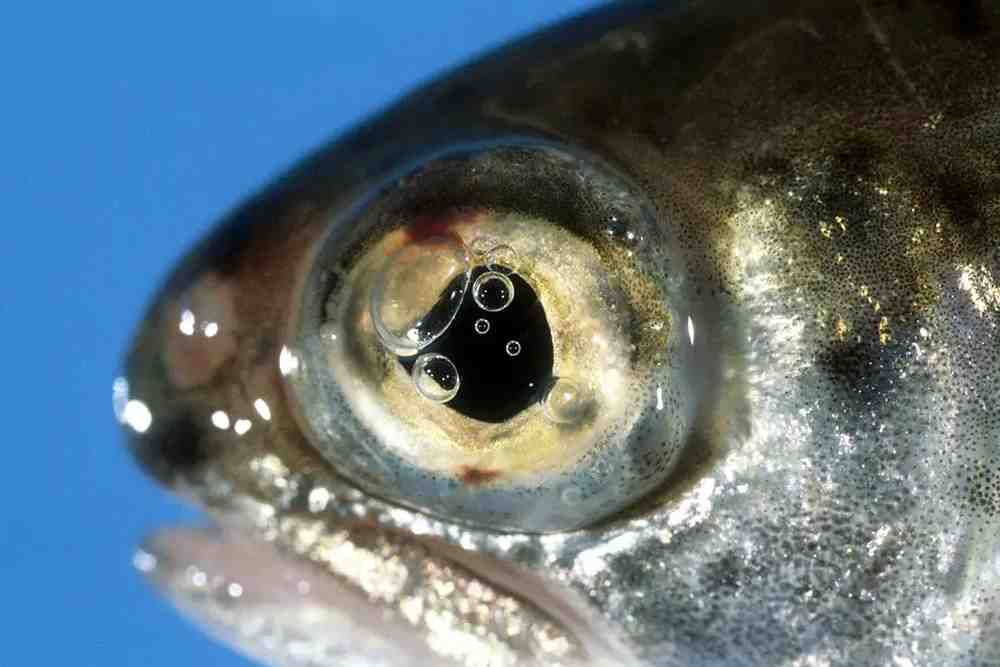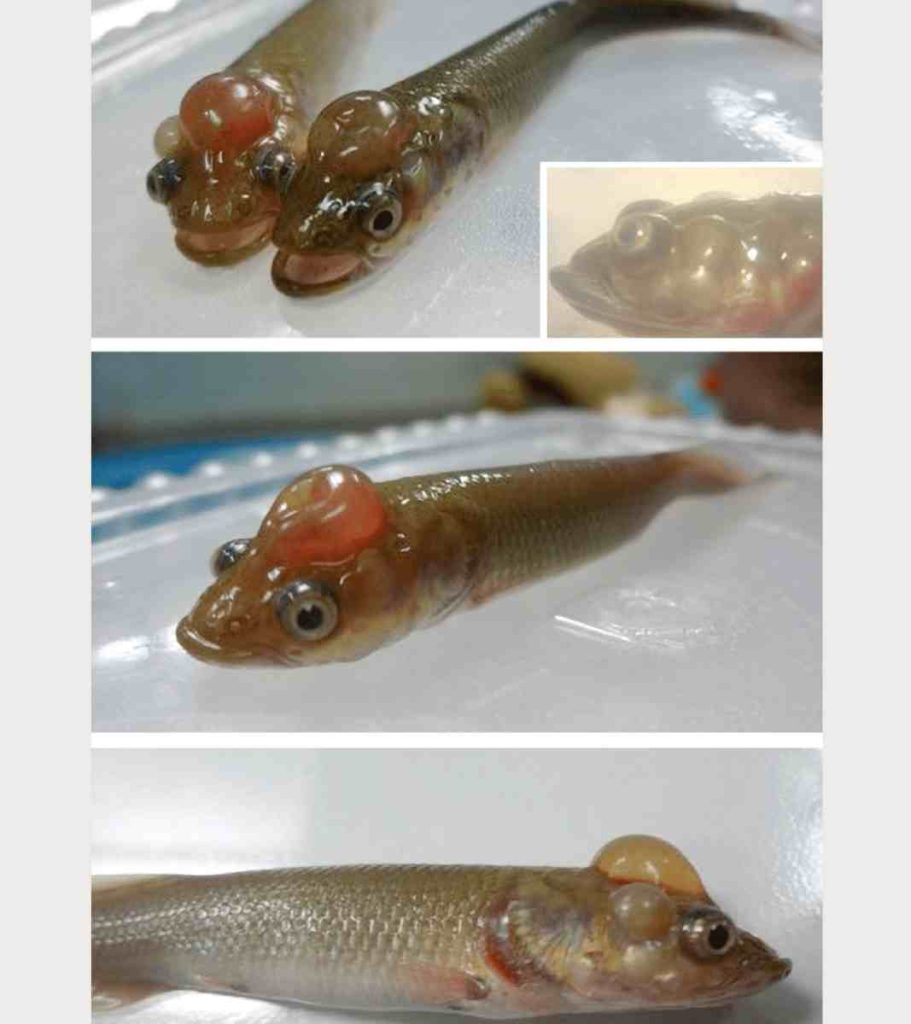Gas bubble disease, also known as gas supersaturation, is a common and potentially fatal condition that affects fish all around the world.
Gas bubble disease in fish is a physiologically produced, non-infectious condition brought on by complete dissolved gas hyperbaric pressure that is not adjusted.
The article provide a clear brief about gas bubble disease in fish with it’s causes, signs and symptoms, treatment and prevention.

Causes of Gas Bubble Disease in Fish
Gas bubble disease (GBD) is caused by the formation of gas bubbles in the tissues and bloodstream of fish.
This can occur when the water in which the fish are living becomes supersaturated with dissolved gases, such as nitrogen and oxygen, which then come out of solution and form bubbles inside the fish.
Here are some common causes of gas bubble disease in fish:
Sudden changes in water pressure: Rapid changes in water pressure, such as those that occur during water changes or when fish are moved between tanks or ponds, can cause gases to come out of solution and form bubbles in the fish.
High water temperature: Warm water can hold less dissolved gas than cold water, so if the temperature of the water increases, it can become supersaturated with gas, leading to the formation of bubbles in the fish.
Water may contain more gas when under high pressure or at low temperatures. Both natural and man-made factors can lead to gas supersaturation in water.
Low water oxygen levels: When water has low oxygen levels, fish may begin to breathe air at the water’s surface. As they do so, they may also swallow air, which can lead to the formation of bubbles in their bodies.
High water nitrogen levels: Nitrogen is an inert gas that is commonly used to aerate water. However, if too much nitrogen is introduced into the water, it can become supersaturated with gas and lead to the formation of bubbles in fish.
Water contaminated with gas: Sometimes, water may become contaminated with gas, such as carbon dioxide or methane, which can then be absorbed by the fish and lead to the formation of bubbles.
Algal blooms: During algal blooms, water can become supersaturated with oxygen, leading to the formation of bubbles in fish.
Signs & Symptoms of Gas Bubble Disease in Fish

Gas bubble disease (GBD) is a condition that affects fish when dissolved gases, such as nitrogen and oxygen, come out of solution and form bubbles inside their bodies.
These bubbles can cause a range of symptoms that can vary depending on the severity of the condition.
Here are some signs and symptoms of gas bubble disease in fish:
- Gas bubbles: Fish with GBD will often have bubbles visible under their skin or in their eyes.
- Buoyancy problems: Fish may have difficulty swimming, floating upside down, or floating at the surface.
- Loss of equilibrium: Fish may lose their balance or have trouble maintaining their position in the water.
- Rapid breathing: Fish may breathe rapidly, as their gills try to compensate for the reduced oxygen levels.
- Red or inflamed skin: Fish with GBD may have red or inflamed skin, especially around the eyes and gills.
- Lethargy: Fish may appear weak, tired, and inactive.
- Loss of appetite: Fish may refuse to eat or lose interest in food.
- Death: In severe cases, GBD can lead to death.
Treatment of Gas Bubble Disease
It’s important to monitor the water conditions in your fish tank or pond and take steps to prevent any sudden changes in pressure, temperature, or gas levels that could lead to the formation of bubbles in fish.
- As soon as you see the signs of gas bubble disease, move the fish to a tank with 10-15 mg/l of ideal oxygen as soon as you can.
- Reduce the amount of plants in the aquarium if this isn’t possible, and use cubes with coarse holes to apply intense water aeration (large bubbles).
- Limiting the use of harsh lighting is also a smart idea. The main aquarium should be left alone to allow the saturated gases in the water to equalize with the ambient air’s pressure.
- Unless the body’s alterations are sufficiently advanced, all gas sickness symptoms in our patients should go away within a few days (e.g. damage to the gills).
After this time, the fish can be returned to the main tank where their immune systems can be strengthened by using the proper vitamin and water treatment solutions.
Prevention of Gas Bubble Disease
Here are some steps you can take to prevent gas bubble disease in fish:
Maintain good water quality: Regularly test the water in your aquarium and make sure that the pH, ammonia, nitrite, and nitrate levels are within the appropriate range for your fish. Conduct partial water changes regularly to maintain good water quality.
Avoid sudden changes in pressure: Avoid exposing your fish to sudden changes in pressure by handling them gently during transport or when moving them to a new aquarium. Make sure to acclimate your fish slowly to any changes in water conditions, such as temperature or salinity.
Provide proper aquarium setup: Ensure that your aquarium is properly set up with appropriate filtration, aeration, and water circulation to ensure that the water remains oxygenated and free from harmful chemicals.
Monitor the behavior of your fish: Keep a close eye on the behavior of your fish and look out for any signs of distress or illness, such as gasping for air, lethargy, or swimming abnormally.
Consult with a veterinarian: If you suspect that your fish may be suffering from gas bubble disease or any other health condition, consult with a veterinarian who specializes in fish health. They can provide you with guidance on how to treat and prevent the condition.
By taking these steps, you can help prevent gas bubble disease and ensure the health and well-being of your fish.
FAQs
Is fish gas bubble disease contagious?
Gas bubble illness, which is not contagious, is brought on by excessive concentrations of all dissolved gases in the water.
Gas bubbles that build up in the tissues and blood vessels of fish lead to lesions.
What is gas supersaturation?
When water has more dissolved gas than it can typically store in solution at a specific temperature and atmospheric pressure, this is known as supersaturation.
What does gas bubble disease look like in fish?
Fish suffering from gas bubble disease will often have visible gas bubbles on their body, fins, and gills. These bubbles may appear white or clear and can be seen just under the skin.
How long does a gas bubble last?
The duration of gas bubbles in fish can vary depending on the severity of the condition and the underlying cause.
In mild cases, gas bubbles may dissipate on their own within a few days. However, in more severe cases, treatment may be required to alleviate the symptoms and prevent further complications.
Fish bubble vs gas bubble disease
It’s important to differentiate between two similar-sounding conditions in fish tank: gas bubble disease and fish bubble.
Gas bubble disease occurs when gas bubbles form in a fish’s tissues and bloodstream due to a sudden change in pressure or poor water quality.
Some fish species are known to create bubble nests as part of their breeding behavior, while others may create bubbles as a result of their swim bladder function.
References
- Espmark, A. M., Hjelde, K., & Baeverfjord, G. (2010). Development of gas bubble disease in juvenile Atlantic salmon exposed to water supersaturated with oxygen. Aquaculture, 306(1-4), 198-204.
- Saeed, M. O., & Al‐Thobaiti, S. A. (1997). Gas bubble disease in farmed fish in Saudi Arabia. Veterinary Record, 140(26), 682-684.
- Liu, X., Li, N., Feng, C., Fu, C., Gong, Q., Lai, J., … & Shi, H. (2019). Lethal effect of total dissolved gas-supersaturated water with suspended sediment on river sturgeon (Acipenser dabryanus). Scientific Reports, 9(1), 13373.